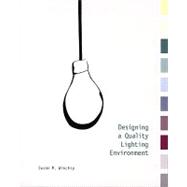
Note: Supplemental materials are not guaranteed with Rental or Used book purchases.
Purchase Benefits
What is included with this book?
| Introduction to Lighting | |
| Lighting Environments | |
| Lighting Systems | |
| Electrical Sources | |
| Lighting Systems | |
| Lamps for Special Applications | |
| Colour | |
| Directional Effects of Lighting | |
| Quantity of Light | |
| Electricity | |
| Lighting Systems | |
| Luminaires | |
| Lighting Systems | |
| Controls | |
| Portable Luminaires and Styles of Fixtures | |
| Energy and the Environment | |
| Illumination and Human Factors | |
| Safety and Security | |
| Illuminating Visual Art | |
| Text Features | |
| Lighting recommendations and practices based on current research | |
| Human factors associated with lighting, including the needs of special populations, the effects of lighting on health, productivity and behaviour, and spatial interpretations | |
| Current issues in energy conservation, "green design", light pollution, light trespass, and international implications | |
| Case studies demonstrating the best practices for lighting design in residential and commercial fields | |
| Design strategies from the needs of a client, user, and architectural details | |
| Colour photographs specially chosen to demonstrate how quality lighting has been achieved in residential and commercial spaces | |
| Design projects, exercises, and Internet assignments to reinforce text material | |
| Appendix includes the Munsell colour system, lighting guides, shapes of lamps, beam spread charts, fixture light distribution, lighting documents, lighting symbols, lighting-related abbreviations, Internet resources, selected bibliography, lighting manufacturers and suppliers, lighting and professional organisations, and glossary | |
| Instructor's Guide | |
| Table of Contents provided by Publisher. All Rights Reserved. |
The New copy of this book will include any supplemental materials advertised. Please check the title of the book to determine if it should include any access cards, study guides, lab manuals, CDs, etc.
The Used, Rental and eBook copies of this book are not guaranteed to include any supplemental materials. Typically, only the book itself is included. This is true even if the title states it includes any access cards, study guides, lab manuals, CDs, etc.